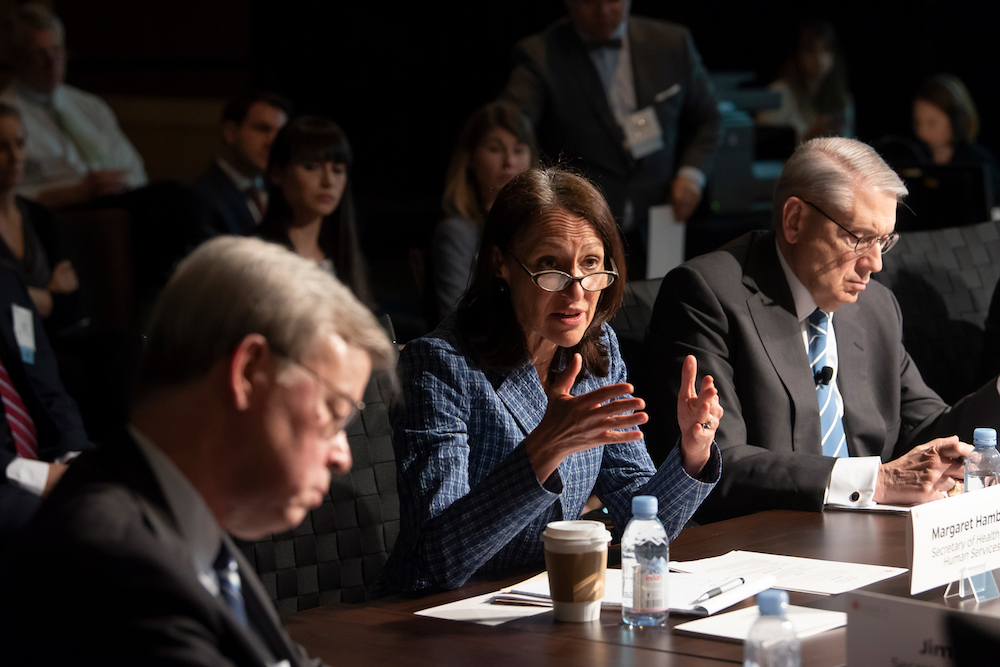The outbreak of a moderately contagious and moderately lethal novel pathogen precipitated a catastrophic end to the scenario in Clade X, the day-long pandemic tabletop exercise hosted by the Johns Hopkins Center for Health Security on May 15 in Washington, DC.
Clade X simulated a series of National Security Council–convened meetings of 10 US government leaders, played by individuals prominent in the fields of national security or epidemic response. Their dialogue as the scenario unfolded addressed significant uncertainties in current prevention and response capabilities, hamstrung by policy challenges at the federal level.
 Margaret Hamburg in her exercise role as US Secretary of Health and Human Services, flanked at the Clade X EXCOMM table by Jim Talent (left) and Jeff Smith.The scenario opens with the present-day outbreak of a new, serious respiratory disease in Germany and Venezuela. Soon after, Clade X is identified as a novel strain of human parainfluenza virus with genetic elements of Nipah virus. In the weeks that follow a fringe group bent on reducing the human population claims responsibility for the creation and intentional release of the disease. Authorities confirm those claims and verify that the novel strain was indeed engineered by the group’s scientists. There is no vaccine, and pressure grows as pockets of cases appear in the United States. Clade X quickly causes widespread, worldwide anxiety as case counts and deaths mount. Within a year, 150 million people die from the disease—15 million in the United States alone.
Margaret Hamburg in her exercise role as US Secretary of Health and Human Services, flanked at the Clade X EXCOMM table by Jim Talent (left) and Jeff Smith.The scenario opens with the present-day outbreak of a new, serious respiratory disease in Germany and Venezuela. Soon after, Clade X is identified as a novel strain of human parainfluenza virus with genetic elements of Nipah virus. In the weeks that follow a fringe group bent on reducing the human population claims responsibility for the creation and intentional release of the disease. Authorities confirm those claims and verify that the novel strain was indeed engineered by the group’s scientists. There is no vaccine, and pressure grows as pockets of cases appear in the United States. Clade X quickly causes widespread, worldwide anxiety as case counts and deaths mount. Within a year, 150 million people die from the disease—15 million in the United States alone.
At the conclusion of the exercise, the Center presented 6 strategic policy goals needing commitment from the United States to prevent or reduce the worst possible outcomes in future pandemics. Those recommendations are:
- Develop capability to produce new vaccines and drugs for novel pathogens within months not years.
- Pioneer a strong and sustainable global health security system.
- Build a robust, highly capable national public health system that can manage the challenges of pandemic response.
- Develop a national plan to effectively harness all US healthcare assets in a catastrophic pandemic.
- Implement an international strategy for addressing research that increases pandemic risks.
- Ensure the national security community is well prepared to prevent, detect, and respond to infectious disease emergencies.
A full description of each policy recommendation is available on the Clade X website, along with video recordings of the four exercise segments.
In the weeks ahead, the Center’s Clade X project team will synthesize the most important points from unscripted discussions among players during the exercise and disseminate those findings widely among members of the US and international biosecurity policy communities.
About the Johns Hopkins Center for Health Security:
The Johns Hopkins Center for Health Security works to protect people from epidemics and disasters and build resilient communities through innovative scholarship, engagement, and research that strengthens the organizations, systems, policies, and programs essential to preventing and responding to public health crises. The Center is part of the Johns Hopkins Bloomberg School of Public Health and is located in Baltimore, MD.